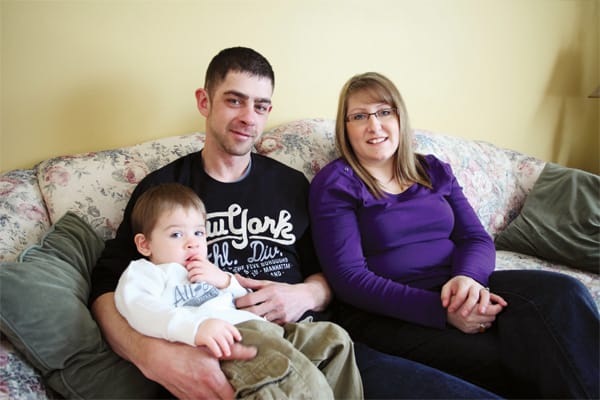If there is a good way for any medical emergency to unfold, then maybe Vinnie Morash was lucky enough to experience such a thing. When he was suddenly stricken with a grand mal seizure caused by a malignant brain tumour on a Monday in February 2012, the 32-year-old had just arrived safely home from work, had hidden his wife Shawna’s Valentine’s gift, and was still somewhat coherent when she and their six-month-old son, Landon, arrived home.
Today, Vinnie, 33, who bears a white, C-shaped scar visible through his short, dark hair as testament to the event, has no recollection of the episode. “It’s just blank,” he says. “I don’t remember anything about that day or the next. It’s like I wasn’t even in the world.”
But he realizes just how fortunate he was to be in the right place at the right time when his seizures struck. If he’d been at his construction job, he could have fallen off a roof. If he’d been driving, he could have gone off the road and killed or hurt someone else in addition to himself.
“Something was not right”
Shawna, 30, has had to recount the dramatic events for Vinnie. “When I got home with the baby an hour after he did, I looked at him and I could tell something was wrong,” Shawna says. “He was confused and in a daze. To be honest, I wondered if he’d been drinking. He kept trying to clear his throat. Something was definitely not right with him.”
As she moved through their Whites Lake, NS, home, Shawna noticed some other strange things. In the bedroom, the curtains were criss-crossed and the bed was half-made. “It was obvious he’d been in bed, but he didn’t remember any of it. I asked him repeatedly what was wrong and he kept saying, ‘nothing.’”
She called Vinnie’s father, Lloyd Morash, and, after he tried to talk to Vinnie on the phone, he agreed with Shawna that something was not right with his son.
Ten minutes later, as Shawna waited for Lloyd to arrive, Vinnie went into a grand mal seizure while sitting in a rocking chair by their living room window.
“His muscles were convulsing, his eyes rolled back into his head, he was shaking, his breath was ragged,” Shawna says. “I called 911 because I knew at that point he was taking a seizure. I had no idea why.”
Lloyd arrived during the seizure and 911 operators advised them to lay Vinnie flat on the floor and tilt his head back to open up his airway. Soon, firefighters arrived at their Whites Lake home. The paramedics showed up not long after that.
Difficult choices
When he arrived at the QEII Health Sciences Centre in Halifax, Vinnie had another seizure. He was quickly given medication to halt it, and was taken for a CT scan. Before long, Shawna and her family learned that Vinnie had a spot on his brain, and that neurosurgeon, Dr. Simon Walling, would be assigned to handle his case.
Also assigned to his case was Karen Vickers, the “brain tumour nurse,” a 33-year veteran neurosurgery nurse whose role was created four years ago by the Division of Neurosurgery with the goal of providing patient education, support and navigation through the cancer care system. “It was wonderful to have Karen Vickers always there by our side, explaining things to us,” says Shawna.
Vinnie remembers waking up in the hospital on Wednesday morning feeling very stiff and sore due to the muscle contractions caused by the seizures. “I couldn’t understand why I was so sore and tensed up. Dr. Walling came in to explain everything to me and I was shocked. I couldn’t believe it, really. It was mind-blowing. Everything was starting to come together, and I was wondering why this was happening and what was going to go on.”
An MRI showed that the most aggressive part of Vinnie’s tumour was in the right frontal lobe, which controls purposeful behaviours, decision-making and problem-solving. But the tumour also extended into the temporal lobe, which controls memory, emotions, hearing, language and learning.
“Dr. Walling explained that he was presented with two choices,” says Shawna. “He could go in and take a small piece of the tumour to analyze it or he could go in to do a full craniotomy to remove as much as they could. But he knew from looking at Vinnie’s MRI that it would be too dangerous to remove the bit of tumour in the temporal lobe. It could cause complications, like a stroke.”
Vickers says, “When the surgeons go in to remove a brain tumour, they take out as much as they safely can without causing the patient any further neurological problems. What they remove depends on the area of the brain the tumour is in. If it’s around his motor strip [a part of the frontal lobe that controls muscle movement, including voluntary movement, swallowing, and speech], for example, they would stop. They wouldn’t want him to not be able to move on one side or the other.”
The surgery
After an emotional good-bye with friends and family, Vinnie was wheeled into surgery for a full craniotomy three days after his arrival at the QEII. Surgery took five long hours; Shawna, and Vinnie’s mother, Susan, waited for news.
“Dr. Walling came to see us when Vinnie went to recovery,” says Shawna. “He said it went well and that he got everything he wanted to get out—that Vinnie was doing fine.”
After the tissue went to pathology, Dr. Walling was able to tell them that Vinnie had a grade II oligodendroglioma, which is a low grade tumour considered to be slow-growing. “The tumour was calcified, hard tissue, so it was probably there for many years before causing these symptoms,” says Shawna.
Statistics show that only a small percentage of brain tumours are oligodendrogliomas. They are often found in adults, but occur in young children, too. Dr. Walling sees adult patients at the QEII and children at the IWK. “[Tumours] can affect anybody at any age,” says Vickers. “Symptoms will depend on where the tumour is located in the brain, and can include seizures, weakness, speech problems, or changes in cognition. But once the tumour is found, the doctors don’t fool around. If it looks like something that needs to come out quickly, the patient is admitted and it comes out within a few days.”
No known cause
What caused Vinnie’s brain tumour, or what causes brain tumours in general, still requires much more medical research. “There’s no known cause for brain tumours,” says Vickers. “Patients are not thought to be genetically predisposed to them. There’s nothing concrete about what causes them, and nothing that people do to cause them or to prevent them.”
Vinnie was discharged from hospital two days after his surgery. “We can’t say enough good things about the entire staff,” Shawna says. “When we left, I hugged Dr. Walling, and Vinnie shook his hand. You don’t really appreciate the staff and what they do until you’re in there. And afterwards, we could always contact Karen and ask questions.”
Choosing a course of action
While radiation is often a course of action following a brain tumour, radiation oncologist Dr. Dorianne Rheaume suggested that, in Vinnie’s case, they put it on the back burner since radiation can also affect normal brain cells. Medical oncologist Dr. Mary MacNeil, whom they’ve seen a few times over the last year, suggested that chemotherapy will be a better course of action for Vinnie if the time comes.
“Until it starts growing again or doing something, that’s when they’ll intervene. As of now, he’s healthy, he’s being monitored, and he’s doing great,” says Shawna.
Vinnie has had frequent MRIs over the past year to monitor the remaining tumour in his temporal lobe; it has remained stable. He’s taking Dilantin, an anti-seizure medication, to ward off seizures, and may be on it for the rest of his life. “There’s no guarantee there’s not going to be another seizure,” says Shawna. “There’s still a possibility that the remainder of the tumour will grow again. As of right now, he doesn’t need any treatment. They’re just going to watch it with frequent MRIs. At first, they were three months apart and now they’re six months apart. Everything is very stable and good.”

Staying healthy
Vinnie’s only limitations are that he can’t work to exhaustion or get too little sleep, because those things can bring down the threshold of the Dilantin, as can drinking too much alcohol.
More than a year later, Vinnie feels the same as he did before the tumour. “I was off work for three months to allow my skull to heal and I wasn’t permitted to drive for six months. Now, I can live just as I did before.”
Vinnie believes in having a healthy mindset about his health emergency. He won’t let himself dwell on it. “I don’t let it get to me,” he says. “We know that it’s there, but I’m not going to get up and wonder if today’s the day something happens.”
Otherwise, the couple is grateful and happy things unfolded the way they did. They also appreciate the wonderful support they’ve received from their families and the community, who helped them by making donations and putting together a benefit while Vinnie was off work and Shawna continued her maternity leave.
“It meant the world to us, knowing we had so much support from our family, friends and community,” says Shawna. “It was very overwhelming and we are truly thankful from the bottom of our hearts for all the kind words and support. It makes you realize that when life takes the wrong turn, you can count on so many people to come together and help. We’ve learned that life is precious. We don’t take one minute for granted, and we live each day as it comes.”
